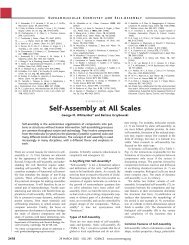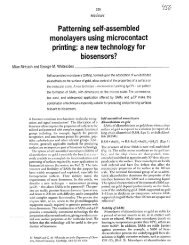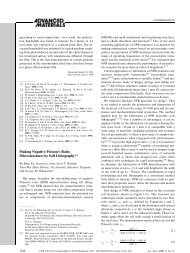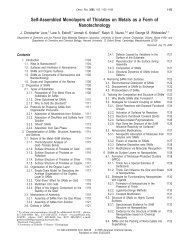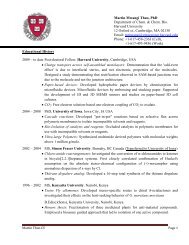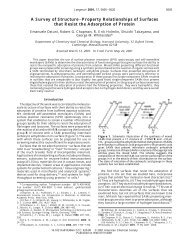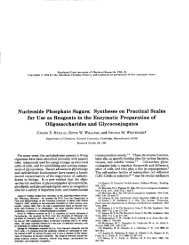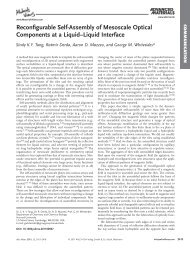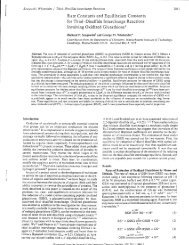Zwitterionic SAMs that Resist Nonspecific Adsorption of Protein from ...
Zwitterionic SAMs that Resist Nonspecific Adsorption of Protein from ...
Zwitterionic SAMs that Resist Nonspecific Adsorption of Protein from ...
You also want an ePaper? Increase the reach of your titles
YUMPU automatically turns print PDFs into web optimized ePapers that Google loves.
<strong>Zwitterionic</strong> <strong>SAMs</strong> <strong>that</strong> <strong>Resist</strong> <strong>Nonspecific</strong> <strong>Adsorption</strong> <strong>of</strong><br />
<strong>Protein</strong> <strong>from</strong> Aqueous Buffer<br />
R. Erik Holmlin, Xiaoxi Chen, Robert G. Chapman, Shuichi Takayama, and<br />
George M. Whitesides*<br />
Department <strong>of</strong> Chemistry and Chemical Biology, Harvard University, 12 Oxford Street,<br />
Cambridge, Massachusetts 02138<br />
Received October 31, 2000. In Final Form: February 23, 2001<br />
This paper describes the use <strong>of</strong> surface plasmon resonance spectroscopy and self-assembled monolayers<br />
(<strong>SAMs</strong>) <strong>of</strong> alkanethiols on gold to evaluate the ability <strong>of</strong> surfaces terminating in different combinations<br />
<strong>of</strong> charged groups to resist the nonspecific adsorption <strong>of</strong> proteins <strong>from</strong> aqueous buffer. Mixed <strong>SAMs</strong> formed<br />
<strong>from</strong> a 1:1 combination <strong>of</strong> a thiol terminated in a trimethylammonium group and a thiol terminated in<br />
a sulfonate group adsorbed less than 1% <strong>of</strong> a monolayer <strong>of</strong> two proteins with different characteristics:<br />
fibrinogen and lysozyme. Single-component <strong>SAMs</strong> formed <strong>from</strong> thiols terminating in groups combining<br />
a positively charged moiety and a negatively charged moiety were also capable <strong>of</strong> resisting the adsorption<br />
<strong>of</strong> proteins. Single-component <strong>SAMs</strong> presenting single charges adsorbed nearly a full monolayer <strong>of</strong> protein.<br />
The amount <strong>of</strong> protein <strong>that</strong> adsorbed to mixed zwitterionic <strong>SAMs</strong> did not depend on the ionic strength or<br />
the pH <strong>of</strong> the buffer in which the protein was dissolved. The amount <strong>of</strong> protein <strong>that</strong> adsorbed to singlecomponent<br />
zwitterionic <strong>SAMs</strong> increased as the ionic strength <strong>of</strong> the buffer decreased; it also decreased as<br />
the pH <strong>of</strong> the buffer increased (at constant ionic strength). Single-component zwitterionic <strong>SAMs</strong> composed<br />
<strong>of</strong> thiols terminating in N,N-dimethyl-amino-propane-1-sulfonic acid (-N + (CH3)2CH2CH2CH2SO3 - ) groups<br />
were substantially more effective at resisting adsorption <strong>of</strong> fibrinogen and lysozyme <strong>from</strong> buffer at<br />
physiological ionic strength and pH than single-component zwitterionic <strong>SAMs</strong> composed <strong>of</strong> thiols terminating<br />
in phosphoric acid 2-trimethylamino-ethyl ester (-OP(O)2 - OCH2CH2N + (CH3)3). Several <strong>of</strong> these zwitterionic<br />
<strong>SAMs</strong> were comparable to the best known systems for resisting nonspecific adsorption <strong>of</strong> protein.<br />
Introduction<br />
This paper characterizes the ability <strong>of</strong> self-assembled<br />
monolayers (<strong>SAMs</strong>) on gold <strong>that</strong> present positively and<br />
negatively charged groups to resist the nonspecific adsorption<br />
<strong>of</strong> protein <strong>from</strong> aqueous buffer. 1 Throughout this<br />
paper, we use two condensed phrases for brevity: (i) the<br />
phrase “zwitterionic <strong>SAMs</strong>” refers both to <strong>SAMs</strong> formed<br />
<strong>from</strong> a 1:1 mixture <strong>of</strong> positively and negatively charged<br />
thiols and to <strong>SAMs</strong> formed <strong>from</strong> thiols <strong>that</strong> combine a<br />
positively charged moiety and a negatively charged moiety<br />
in the same molecule and (ii) the phrase “inert surface”<br />
refers to any surface <strong>that</strong> resists nonspecific adsorption<br />
<strong>of</strong> protein <strong>from</strong> aqueous buffer. 1<br />
<strong>Nonspecific</strong> adsorption <strong>of</strong> proteins to synthetic surfaces<br />
is an important consideration in a range <strong>of</strong> areas; examples<br />
include substrates for cell culture, 2,3 materials for protein<br />
purification, 4 prostheses, 5 contact lenses, 6,7 in-dwelling<br />
sensors, 8 and catheters. 8 Here, we have combined surface<br />
plasmon resonance (SPR) spectroscopy and <strong>SAMs</strong> to<br />
* To whom correspondence should be addressed. E-mail:<br />
gwhitesides@gmwgroup.harvard.edu.<br />
(1) Mrksich, M.; Whitesides, G. M. Annu. Rev. Biophys. Biomol. Struct.<br />
1996, 25, 55-78.<br />
(2) Lopez, G. P.; Tender, L. M.; Bradley, G.; Opperman, K. A.;<br />
Hampton, P. D. Proc. SPIE-Int. Soc. Opt. Eng. 1997, 2798, 2-11.<br />
(3) Chen, C. S.; Mrksich, M.; Huang, S.; Whitesides, G. M.; Ingber,<br />
D. E. Science 1997, 276, 1425-1428.<br />
(4) Nishimura, T. Polymer Materials for Blood Purification; Tsuruta,<br />
T., Hayashi, T., Kataoka, K., Ishihara, K., Kimura, Y., Eds.; CRC Press:<br />
Boca Raton, FL, 1993.<br />
(5) Gristina, A. G.; Giridhar, G.; Gabriel, B. L.; Naylor, P. T.; Myrvik,<br />
Q. N. Int. J. Artif. Organs 1993, 16, 755-764.<br />
(6) Holden, B. A.; Reddy, M. K.; Sankaridurg, P. R.; Rajeev, B.;<br />
Sharma, S.; Wilcox, M. D. P.; Morris, C.; Sweeney, D. F.; Rao, G. N.<br />
Invest. Ophthalmol. Visual Sci. 1997, 38, 981.<br />
(7) Dickinson, G. M.; Bisno, A. L. Int. J. Artif. Organs 1993, 16, 749-<br />
754.<br />
(8) Sickler, D. J.; McLean, R. J. C. Cells Mater. 1995, 5, 167-182.<br />
Langmuir 2001, 17, 2841-2850<br />
2841<br />
study the adsorption <strong>of</strong> proteins to zwitterionic <strong>SAMs</strong>.<br />
The objective <strong>of</strong> the work was to guide the design <strong>of</strong> new<br />
materials <strong>that</strong> resist the adsorption <strong>of</strong> protein.<br />
Surfaces That <strong>Resist</strong> <strong>Protein</strong> <strong>Adsorption</strong>. PEG.<br />
Poly(ethylene glycol) (PEG) is a water soluble, electrically<br />
neutral polyether <strong>that</strong> has been widely used as a coating<br />
for biomedical devices. 9 Incorporating PEG as a copolymer<br />
in polymeric materials or grafting it onto the surface <strong>of</strong><br />
biomaterials increases the biocompatibility <strong>of</strong> these<br />
surfaces. 9,10 Surfaces covered with a low density <strong>of</strong> PEG<br />
high molecular weight ((EG)n, n ∼ 30) have the characteristic<br />
<strong>that</strong> they resist nonspecific adsorption <strong>of</strong> protein; 10<br />
this low protein adsorption 11,12 is one key aspect <strong>of</strong> the<br />
biocompatibility <strong>that</strong> PEG affords. Although PEG has been<br />
a useful component <strong>of</strong> biomaterials, it is susceptible to<br />
autoxidation in the presence <strong>of</strong> dioxygen and transition<br />
metal ions. 13-15 In addition, the terminal hydroxyl group<br />
<strong>of</strong> PEG can be oxidized by alcohol dehydrogenase to an<br />
aldehyde; there is concern <strong>that</strong> this aldehyde may react<br />
with proteins in vivo and with other molecules having<br />
amine groups. The aldehyde can be oxidized further by<br />
aldehyde dehydrogenase. 16,17 There is great interest in<br />
identifying alternatives to PEG. 18<br />
(9) Harris, J. M.; Zalipsky, S. Poly(ethylene glycol): Chemistry and<br />
Biological Applications; American Chemical Society: Washington, DC,<br />
1997.<br />
(10) McPherson, T.; Kidane, A.; Szleifer, I.; Park, K. Langmuir 1998,<br />
14, 176-186.<br />
(11) (a) Jenney, C. R.; Anderson, J. M. J. Biomed. Mater. Res., 1999,<br />
44, 206-216. (b) Deible, C. R.; Petrosko, P.; Johnson, P. C.; Beckman,<br />
E. J.; Russell, A. J.; Wagner, W. R. Biomaterials 1998, 19, 1885-1893.<br />
(12) Leckband, D.; Sheth, S.; Halperin, A. J. Biomater. Sci., Polym.<br />
Ed. 1999, 10, 1125-1147.<br />
(13) Hamburger, R.; Azaz, E.; Donbrow, M. Pharm. Acta Helv. 1975,<br />
50, 10-17.<br />
(14) Gerhardt, W.; Martens, C. Z. Chem. 1985, 25, 143.<br />
(15) Crouzet, C.; Decker, C.; Marchal, J. Makromol. Chem. 1976,<br />
177, 145-157.<br />
10.1021/la0015258 CCC: $20.00 © 2001 American Chemical Society<br />
Published on Web 04/06/2001
2842 Langmuir, Vol. 17, No. 9, 2001 Holmlin et al.<br />
Other Surface-Grafted Polymers That <strong>Resist</strong> the <strong>Adsorption</strong><br />
<strong>of</strong> <strong>Protein</strong>s. Polymers other than PEG have been<br />
explored for biomedical applications. Rabinow et al. 19<br />
compared the protein resistance <strong>of</strong> PEG, poly(vinyl alcohol)<br />
(PVA), polyethyloxazoline (PEOX), and poly(vinylpyrrolidone)<br />
(PVP) when the polymers were incorporated into<br />
polymer films. PVP, PEOX, and PVA all reduced the<br />
amount <strong>of</strong> protein adsorption relative to the amount <strong>that</strong><br />
adsorbed on unmodified polymer films. In these comparisons,<br />
PEG performed the best. Several groups have<br />
examined surfaces derivatized with carbohydrates. Österberg<br />
et al. 20 found <strong>that</strong> derivatives <strong>of</strong> cellulose grafted<br />
to polystyrene were nearly as effective as PEG at<br />
preventing protein adsorption. Polysaccharides crosslinked<br />
to poly(ethylenimine) (PEI) bound noncovalently<br />
to polystyrene also reduced the amount <strong>of</strong> protein adsorption<br />
to the polymer surface. 21 Preadsorption <strong>of</strong> methyl<br />
cellulose or poly(vinyl methyl ether) to hydrophobic<br />
membranes used for ultrafiltration reduced the amount<br />
<strong>of</strong> protein <strong>that</strong> adsorbs to the pore walls <strong>of</strong> the membrane. 22<br />
Chapman et al. grafted PEI to <strong>SAMs</strong> and acylated the<br />
free amine groups to give polymer films containing high<br />
concentrations <strong>of</strong> various N-acyl groups. 23 The functionalized<br />
PEI films formed inert surfaces either when the<br />
N-acyl derivative contained an oligomer <strong>of</strong> EG or when it<br />
contained an acetyl group.<br />
<strong>SAMs</strong> That <strong>Resist</strong> the <strong>Adsorption</strong> <strong>of</strong> <strong>Protein</strong>s. <strong>SAMs</strong> <strong>of</strong><br />
alkanethiols terminated in different functional groups<br />
have been used to study the physical-organic chemistry<br />
<strong>of</strong> the adsorption <strong>of</strong> proteins to synthetic surfaces. <strong>SAMs</strong><br />
<strong>that</strong> present a high density <strong>of</strong> short oligomers <strong>of</strong> EG ((EG)n,<br />
n ) 3-6) resist the adsorption <strong>of</strong> proteins to the same<br />
extent as surfaces coated with a relatively low density <strong>of</strong><br />
high molecular weight PEG. 24,25 <strong>SAMs</strong> on gold terminated<br />
in oligomers <strong>of</strong> tripropylene sulfoxide are comparable to<br />
<strong>SAMs</strong> presenting (EG)3 in their ability to block nonspecific<br />
protein adsorption 26 found. Using SPR spectroscopy in<br />
combination with a procedure for rapidly incorporating<br />
terminal functional groups on the surface <strong>of</strong> <strong>SAMs</strong> on<br />
gold, we have screened a variety <strong>of</strong> groups for their ability<br />
to render surfaces inert to the adsorption <strong>of</strong> proteins. 27,28<br />
This screening method identified several new groups <strong>that</strong><br />
were previously unrecognized for their ability to resist<br />
protein adsorption.<br />
Considerations for Design <strong>of</strong> Organic Surfaces<br />
<strong>that</strong> <strong>Resist</strong> <strong>Protein</strong> <strong>Adsorption</strong>. (EG)n is not the only<br />
(16) Herold, D. A.; Keil, K.; Bruns, D. E. Biochem. Pharm. 1989, 38,<br />
73-76.<br />
(17) Talarico, T.; Swank, A.; Privalle, C. Biochem. Biophys. Res.<br />
Commun. 1998, 250, 354-358.<br />
(18) Ratner, B. D.; H<strong>of</strong>fmann, F. J.; Schoen, J. E.; Lemons, F.<br />
Biomaterials Science. An Introduction to Materials in Medicine;<br />
Academic Press: New York, 1996.<br />
(19) Rabinow, B. E.; Ding, Y. S.; Qin, C.; McHalsky, M. L.; Schneider,<br />
J. H.; Ashline, K. A.; Shelbourn, T. L.; Albrecht, R. M. J. Biomater. Sci.,<br />
Polym. Ed. 1994, 6, 91-109.<br />
(20) Österberg, E.; Bergstrom, K.; Holmberg, K.; Riggs, J. A.; Van<br />
Alstine, J. M.; Schuman, T. P.; Burns, N. L.; Harris, J. M. Colloids Surf.<br />
1993, 77, 159-169.<br />
(21) Brink, C.; Österberg, E.; Holmberg, K.; Tiberg, F. Colloids Surf.<br />
1992, 66, 149-156.<br />
(22) Brink, L. E. S.; Elbers, S. J. G.; Robertsen, T.; Both, P. J. Membr.<br />
Sci. 1993, 76, 281-289.<br />
(23) Chapman, R. G.; Ostuni, E.; Liang, M. N.; Meluleni, G.; Kim,<br />
E.; Yan, L.; Pier, G.; Warren, H. S.; Whitesides, G. M. Submitted for<br />
publication.<br />
(24) Prime, K. L.; Whitesides, G. M. Science 1991, 252, 1164-1167.<br />
(25) Prime, K. L.; Whitesides, G. M. J. Am. Chem. Soc. 1993, 115,<br />
10714-10721.<br />
(26) Deng, L.; Mrksich, M.; Whitesides, G. M. J. Am. Chem. Soc.<br />
1996, 118, 5136-5137.<br />
(27) Chapman, R. G.; Ostuni, E.; Takayama, S.; Holmlin, R. E.; Yan,<br />
L.; Whitesides, G. M. J. Am. Chem. Soc. 2000, 122, 8304-8304.<br />
(28) Chapman, R. G.; Ostuni, E.; Whitesides, G. M. Langmuir 2000,<br />
16, 6927-6936.<br />
organic group <strong>that</strong> can be used to generate inert surfaces.<br />
A variety <strong>of</strong> functional groups, when presented as terminal<br />
groups on the surface <strong>of</strong> <strong>SAMs</strong> on gold, are comparable<br />
to oligomers <strong>of</strong> EG in resisting protein adsorption. 27 In<br />
general, these groups share four features: they are (i)<br />
hydrophilic, (ii) electrically neutral, (iii) hydrogen bond<br />
acceptors, and (iv) not hydrogen bond donors. This set <strong>of</strong><br />
properties seems to describe many but not all inert<br />
surfaces. In a notable and unexpected exception, Mrksich<br />
has reported <strong>that</strong> <strong>SAMs</strong> terminating in mannose groups<br />
(a hydrogen bond donor) are inert. 29 Conformational<br />
flexibility is also a characteristic <strong>of</strong> many <strong>of</strong> these groups,<br />
but it does not seem to be essential.<br />
The origin <strong>of</strong> resistance to protein adsorption is not yet<br />
clear. When a protein approaches an interface, the energetics<br />
<strong>of</strong> interaction between them contains contributions<br />
<strong>from</strong> van der Waals, electrostatic, and hydrogen-bonding<br />
terms. 30 Electrical neutrality may be important in minimizing<br />
the electrostatic interactions, and the absence <strong>of</strong><br />
hydrogen bond donors may be important in minimizing<br />
the hydrogen bonding interactions, but it has been difficult<br />
to disentangle the individual contributions to account for<br />
the general properties <strong>of</strong> inert surfaces.<br />
This paper explores protein adsorption to <strong>SAMs</strong> composed<br />
<strong>of</strong> alkanethiols functionalized with terminal charged<br />
groups. Charged groups such as quaternary ammonium<br />
groups and alkyl sulfonates have been used extensively<br />
in materials for ion-exchange chromatagraphy. In these<br />
applications, charged analytes (proteins, nucleic acids,<br />
and small molecules) adsorb electrostatically to resins and<br />
are eluted by buffers with high ionic strength. Quaternary<br />
ammonium groups and alkyl sulfonates share three <strong>of</strong><br />
the four common characterstics <strong>of</strong> groups <strong>that</strong> resist<br />
protein adsorption; the exception is <strong>that</strong> they are not<br />
electrically neutral. We hypothesized <strong>that</strong> combining<br />
positively charged and negatively charged groups in a 1:1<br />
ratio at the SAM-buffer interface, either by coadsorbing<br />
two different thiols or by synthesizing a thiol containing<br />
both moieties in the headgroup, might render the surfaces<br />
electrically neutral and might give a new class <strong>of</strong> inert<br />
surfaces. The idea <strong>that</strong> zwitterionic surfaces might be<br />
biocompatible (and perhaps resistant to protein adsorption)<br />
has a precedent in biology: most cell-surface lipids<br />
are zwitterionic, and a variety <strong>of</strong> studies have shown <strong>that</strong><br />
grafting different phosphorylcholine derivatives to surfaces<br />
reduces protein adsorption. 31,32 We wished to examine<br />
zwitterionic surfaces in detail using <strong>SAMs</strong> as model<br />
surfaces.<br />
Experimental Design. <strong>SAMs</strong>. Chart 1 shows the<br />
structures <strong>of</strong> the thiols we have used. Some <strong>of</strong> the different<br />
<strong>SAMs</strong> <strong>that</strong> can be formed <strong>from</strong> them are pictured<br />
schematically in Figure 1. <strong>Adsorption</strong> <strong>of</strong> protein to neutral<br />
<strong>SAMs</strong> formed <strong>from</strong> thiols 1-3 has been studied extensively,<br />
1,25 and we use these <strong>SAMs</strong> as a basis for comparing<br />
adsorption to new surfaces. Using thiols 4-7, we have<br />
prepared <strong>SAMs</strong> <strong>that</strong> can be classified into one <strong>of</strong> three<br />
categories: (i) single-component <strong>SAMs</strong> with single charges<br />
(<strong>SAMs</strong> <strong>of</strong> 4 or 5), (ii) zwitterionic mixed <strong>SAMs</strong> (SAM <strong>of</strong> 4<br />
(29) Luk, Y.-Y.; Kato, M.; Mrksich, M. Langmuir 2000, 16, 9604-<br />
9608.<br />
(30) (a) Cacace, M. G.; Landau, E. M.; Ramsden, J. J. Q. Rev. Biophys.<br />
1997, 30, 241-277. (b) Van Oss, C. J.; Chaudhury, M. K.; Good, R. J.<br />
Chem. Rev. 1988, 88, 927-941.<br />
(31) Murphy, E. F.; Lu, J. R.; Brewer, J.; Russell, J.; Penfold, J.<br />
Langmuir 1999, 15, 1313-1322.<br />
(32) (a) Hayward, J.; Chapman, D. Biomaterials 1984, 5, 135. (b)<br />
Hayward, J. A.; Durrani, A. A.; Shelton, C.; Lee, D. C.; Chapman, D.<br />
Biomaterials 1986, 7, 126. (c) Jia, C.; Haines, A. H. J. Chem. Soc.,<br />
Perkin Trans. 1 1993, 2521. (d) Menger, F. M.; Chen, X. Y.; Brocchini,<br />
S.; Hopkins, H. P.; Hamilton, D. J. Am. Chem. Soc. 1993, 115, 6600.
<strong>Zwitterionic</strong> <strong>SAMs</strong> Langmuir, Vol. 17, No. 9, 2001 2843<br />
Figure 1. Schematic illustrations <strong>of</strong> <strong>SAMs</strong> formed <strong>from</strong> thiols<br />
shown in Chart 1.<br />
Chart 1<br />
and 5 in a 1:1 ratio), and (iii) single-component zwitterionic<br />
<strong>SAMs</strong> (<strong>SAMs</strong> <strong>of</strong> 6 or 7).<br />
<strong>Protein</strong>s. We surveyed a panel <strong>of</strong> proteins <strong>that</strong> vary in<br />
molecular weight and pI to establish the scope <strong>of</strong> the ability<br />
<strong>of</strong> zwitterionic <strong>SAMs</strong> to resist adsorption <strong>of</strong> protein (Table<br />
1). We have examined two <strong>of</strong> these proteins, fibrinogen<br />
and lysozyme, in detail. Fibrinogen is a large (340 kD, pI<br />
) 6.0) protein present in blood plasma <strong>that</strong> adsorbs<br />
strongly to hydrophobic surfaces. 25,28,33 Lysozyme [E.C.<br />
(33) Mrksich, M.; Sigal, G. B.; Whitesides, G. M. Langmuir 1995, 11,<br />
4383-4385.<br />
Table 1. Panel <strong>of</strong> <strong>Protein</strong>s Used for Studies <strong>of</strong><br />
<strong>Adsorption</strong><br />
protein E.C. no. subunits a MW (kD) a pI a<br />
albumin, bovine serumb 1 69 4.8<br />
�-galactosidaseb 3.2.1.23 4 468 5.0<br />
carbonic anhydrase II<br />
(bovine) b<br />
4.2.1.1 1 29.3 5.9<br />
fibrinogen 1 340 6.0<br />
myoglobin 1 17.6 6.8<br />
ribonuclease Ab 3.1.27.5 1 13.7 9.8<br />
cytochrome c 1 12.4 10.0<br />
lysozyme 3.2.1.17 1 14.3 10.9<br />
a See SWISS-PROT database: http://expasy.hcuge.ch/sprot/<br />
sprot-top.html; see also: Colton, I. J.; Anderson, J. R.; Gao, J.;<br />
Chapman, R. G.; Isaacs, L.; Whitesides, G. M. J. Am. Chem. Soc.<br />
1997, 119, 12701-12709. b We use the following abbreviations in<br />
the text and figures to refer to these proteins: albumin, bovine<br />
serum (BSA); �-galactosidase (�-Gal); carbonic anhydrase II (bovine)<br />
(CA); ribonuclease A (RNAse A).<br />
3.2.1.17] is a small protein (14 kD, pI ) 12) <strong>that</strong> is positively<br />
charged under physiological pH (7.0-7.4) where we have<br />
carried out most <strong>of</strong> our studies. 34,35 Lysozyme has been<br />
used widely in model studies <strong>of</strong> electrostatic adsorption<br />
<strong>of</strong> proteins to surfaces. 36<br />
SPR Spectroscopy. SPR spectroscopy provided a convenient<br />
technique with which to monitor the interaction<br />
<strong>of</strong> protein with the synthetic surfaces and to measure the<br />
amount <strong>of</strong> protein <strong>that</strong> adsorbs to these surfaces. 33 SPR<br />
is an optical technique <strong>that</strong> detects changes in the<br />
refractive index above a thin film <strong>of</strong> gold. 37 In our<br />
experiments, we allowed a solution <strong>of</strong> protein in buffer to<br />
flow over the SAM on gold and monitored its adsorption<br />
as a function <strong>of</strong> time; we then replaced the solution <strong>of</strong><br />
protein with buffer to wash away free and weakly bound<br />
protein to reveal the amount <strong>of</strong> protein irreversibly<br />
adsorbed on the SAM. The amount <strong>of</strong> protein adsorbed<br />
was measured in response units (RU, 10 000 RU corresponds<br />
to a shift <strong>of</strong> 1° in the angle <strong>of</strong> incidence <strong>of</strong> light <strong>that</strong><br />
excites surface plasmons in the gold). We report values<br />
<strong>of</strong> ∆RU, which is the change in RU relative to the response<br />
for the clean surface exposed to buffer without protein<br />
(∆RU ) RU buffer+protein - RU buffer ). Equation 1 relates the<br />
percentage <strong>of</strong> a full monolayer <strong>of</strong> protein (% Monolayer,<br />
% ML) adsorbed to a surface to values <strong>of</strong> ∆RU measured<br />
by SPR. 27<br />
%ML) % Monolayer ) ∆RU SAM<br />
∆RU DT<br />
× 100 (1)<br />
This equation is an empirical relation <strong>that</strong> uses the<br />
estimation by Mrksich et al. 33 <strong>that</strong> the value <strong>of</strong> ∆RU for<br />
protein exposed to a methyl-terminated surface reflects<br />
the response for adsorption <strong>of</strong> a full monolayer <strong>of</strong> protein<br />
(here, we use dodecanethiol (DT)). Using it simplifies<br />
comparisons <strong>of</strong> different proteins adsorbing to the same<br />
surface.<br />
Results and Discussion<br />
Synthesis <strong>of</strong> Thiols. Alkanethiol 5 was prepared using<br />
procedures described previously. 38 In the preparation <strong>of</strong><br />
6 (Scheme 1), dimethylamine reacted with 11-bromo-<br />
(34) Robeson, J. L.; Tilton, R. D. Langmuir 1996, 12, 6104-6113.<br />
(35) Roth, C. M.; Lenh<strong>of</strong>f, A. M. Langmuir 1995, 11, 3500-3509.<br />
(36) Kuehner, D. E.; Engann, J.; Fergg, F.; Wernick, M.; Blanch, H.<br />
W.; Prausnitz, J. M. J. Phys. Chem. B 1999, 103, 1368-1374.<br />
(37) L<strong>of</strong>as, S.; Malmqvist, M.; Ronnberg, I.; Stenberg, E.; Liedberg,<br />
B.; Lundstrom, I. Sens. Actuators, B 1991, 5, 79-84.<br />
(38) Tien, J.; Terfort, A.; Whitesides, G. M. Langmuir 1997, 13, 5349-<br />
5355.
2844 Langmuir, Vol. 17, No. 9, 2001 Holmlin et al.<br />
Scheme 1. Reagents and Conditions a<br />
a (a) Trimethylamine, THF, RT, 8 h. (b) 1,3-Propanesulfone,<br />
acetone, RT, 24 h. (c) CH3C(O)SH, ABCN, CH3OH, hν, RT, 16<br />
h. (d) NaOH, H2O, RT, 2 h.<br />
Scheme 2. Reagents and Conditions a<br />
a (a) 2-Chloro-[1,3,2]dioxaphospholane 2-oxide, triethylamine,<br />
THF, -15 °C, 2 h. (b) Trimethylamine, CH2Cl2, 55°C<br />
(sealed bomb), 2 days. (c) CH3C(O)SH, AIBN, CH3OH/H2O (9:<br />
1), hν, RT, 16 h. (d) NaOH, H2O, RT, 2 h.<br />
undec-1-ene to afford N,N-dimethyl-undec-10-enyl-amine<br />
in 99% yield. The resulting tertiary amine reacted with<br />
1,3-propanesultone to give 3-(N,N-dimethyl-undec-10enyl-amino)-propane-1-sulfonic<br />
acid in 79% yield. We<br />
introduced the thiol as the thioacetate by irradiating the<br />
alkene in the presence <strong>of</strong> thioacetic acid; 39 the free thiol<br />
was obtained by hydrolysis <strong>of</strong> the thioacetate with NaOH<br />
in a rigorously degassed aqueous solution. To synthesize<br />
7 (Scheme 2), 2-undec-10-enyloxy-[1,3,2]dioxaphospholane<br />
2-oxide formed (72%) on reaction <strong>of</strong> 2-chloro-[1,3,2]dioxaphospholane-2-oxide<br />
with undec-10-en-1-ol in the<br />
presence <strong>of</strong> triethylamine. Reaction <strong>of</strong> 2-undec-10-enyloxy-<br />
(39) Pale-Grosdemange, C.; Simon, E. S.; Prime, K. L.; Whitesides,<br />
G. M. J. Am. Chem. Soc. 1991, 113, 12-20.<br />
Table 2. Ellipsometric Thicknesses and Advancing<br />
Contact Angles <strong>of</strong> Water and Buffer at pH 10 for <strong>SAMs</strong><br />
Formed <strong>from</strong> Thiols Terminated in Charged Groups<br />
ellipsometric thickness contact angles<br />
thiol used to<br />
form SAM a<br />
estimated<br />
(Å) b<br />
measured<br />
(Å) c<br />
θ CO<br />
(H2O) c,d<br />
θ CO<br />
(pH 10) c,e<br />
4 16 15 ( 2 48 ( 5 35 ( 4<br />
5 16 13 ( 1 52 ( 8 67 ( 4<br />
4 + 5 (1:1) 16 11 ( 1
<strong>Zwitterionic</strong> <strong>SAMs</strong> Langmuir, Vol. 17, No. 9, 2001 2845<br />
given the size <strong>of</strong> the headgroups <strong>that</strong> terminate the<br />
alkanethiols.<br />
To establish the wettability <strong>of</strong> the <strong>SAMs</strong>, we measured<br />
the advancing contact angle <strong>of</strong> water under cyclooctane<br />
(θ CO/H 2 O ) and <strong>that</strong> <strong>of</strong> buffer (pH 10) under cyclooctane<br />
(θ CO/pH 10 ) (Table 2). Sigal et al. 43 have suggested <strong>that</strong> values<br />
<strong>of</strong> θ CO/H 2 O provide a more sensible wettability scale for<br />
studies <strong>of</strong> protein adsorption than do contact angles <strong>of</strong><br />
water under air. We have adopted their procedure for this<br />
work. Single-component <strong>SAMs</strong> with single charges (<strong>SAMs</strong><br />
<strong>of</strong> 4 or 5) were moderately hydrophilic. Mixed zwitterionic<br />
<strong>SAMs</strong> formed <strong>from</strong> a 1:1 mixture <strong>of</strong> 4 and 5 and singlecomponent<br />
<strong>SAMs</strong> formed <strong>from</strong> 6 were wet significantly<br />
better than the single-component <strong>SAMs</strong> with single<br />
charges. The value <strong>of</strong> θ CO/H 2 O for <strong>SAMs</strong> <strong>of</strong> 7 was similar<br />
to <strong>that</strong> <strong>of</strong> the single-component charged <strong>SAMs</strong>; the value<br />
<strong>of</strong> θ CO/pH 10 resembled <strong>that</strong> <strong>of</strong> the zwitterionic <strong>SAMs</strong>. We<br />
presume <strong>that</strong> the effect <strong>of</strong> pH on the wettability <strong>of</strong> <strong>SAMs</strong><br />
<strong>of</strong> 7 reflects deprotonation <strong>of</strong> some fraction <strong>of</strong> phosphodiester<br />
to generate zwitterionic groups. Although the pKa<br />
values <strong>of</strong> these phosphodiester groups are low enough <strong>that</strong><br />
one would expect the <strong>SAMs</strong> to be fully deprotonated at pH<br />
7.4, 44 the pKa values <strong>of</strong> acidic groups on surfaces are known<br />
to be higher than their pKa values in solution. 45 For <strong>SAMs</strong><br />
<strong>of</strong> 7, the phosphodiester is buried in the low dielectric<br />
medium <strong>of</strong> the alkyl monolayer, so the pKa would be<br />
expected to have increased not only as the result <strong>of</strong> being<br />
packed in the monolayer but also as a result <strong>of</strong> poor<br />
solvation <strong>of</strong> the anion by water. The pKa <strong>of</strong> methane<br />
sulfonic acid, for example, increases by 3.2 units in going<br />
<strong>from</strong> water (-2.0) to DMSO (1.2).<br />
<strong>Adsorption</strong> <strong>of</strong> Fibrinogen and Lysozyme to <strong>SAMs</strong>.<br />
Single-Component Charged <strong>SAMs</strong> and Mixed <strong>Zwitterionic</strong><br />
<strong>SAMs</strong>. Figure 2 compares the adsorption <strong>of</strong> fibrinogen<br />
and lysozyme to <strong>SAMs</strong> <strong>of</strong> 4, <strong>SAMs</strong> <strong>of</strong> 5, and mixed <strong>SAMs</strong><br />
formed <strong>from</strong> a 1:1 mixture <strong>of</strong> 4 and 5. The proteins were<br />
dissolved in phosphate buffer (1 mg/mL) at pH 7.4 with<br />
an ionic strength <strong>of</strong> 170 mM. <strong>SAMs</strong> <strong>of</strong> 4 and <strong>SAMs</strong> <strong>of</strong> 5<br />
each adsorbed nearly full monolayers <strong>of</strong> fibrinogen. By<br />
contrast, only ∼1% <strong>of</strong> a monolayer <strong>of</strong> fibrinogen adsorbed<br />
on a SAM formed <strong>from</strong> a 1:1 mixture <strong>of</strong> 4 and 5. This low<br />
level <strong>of</strong> adsorption shows <strong>that</strong> zwitterionic <strong>SAMs</strong> can be<br />
resistant to protein adsorption.<br />
Lysozyme also adsorbed to the single-component <strong>SAMs</strong><br />
with single charges. Even though it has a substantial net<br />
positive charge under the conditions <strong>of</strong> this experiment<br />
(Zp )+7.5 at pH 7.4, 100 mM KCl), 36 lysozyme adsorbed<br />
to the SAM <strong>of</strong> 5, which presents a positively charged<br />
terminal group. The mixed zwitterionic SAM was essentially<br />
completely resistant to adsorption <strong>of</strong> lysozyme.<br />
Single-Component <strong>Zwitterionic</strong> <strong>SAMs</strong>. Figure 2 also<br />
shows sensorgrams for the adsorption <strong>of</strong> fibrinogen and<br />
lysozyme to <strong>SAMs</strong> <strong>of</strong> 6 and 7. <strong>SAMs</strong> <strong>of</strong> 6 adsorbed<br />
more protein than did the mixed zwitterionic SAM; this<br />
amount <strong>of</strong> adsorption was, nevertheless, substantially less<br />
than <strong>that</strong> <strong>of</strong> single-component <strong>SAMs</strong> <strong>of</strong> 4 or 5. <strong>SAMs</strong> <strong>of</strong><br />
7 adsorbed more protein than did <strong>SAMs</strong> <strong>of</strong> 6. One<br />
explanation for the increased adsorption to <strong>SAMs</strong> <strong>of</strong> 7 is<br />
<strong>that</strong> some <strong>of</strong> the phosphodiester is protonated under the<br />
conditions <strong>of</strong> this experiment. Because <strong>SAMs</strong> <strong>of</strong> 7 adsorbed<br />
substantially less protein than did <strong>SAMs</strong> <strong>of</strong> 5 (5<br />
(43) Sigal, G. B.; Mrksich, M.; Whitesides, G. M. J. Am. Chem. Soc.<br />
1998, 120, 3464-3473.<br />
(44) The values <strong>of</strong> pKa <strong>of</strong> n-alkyl phosphodiesters range <strong>from</strong> 1.3 to<br />
1.7 for the homologous series <strong>of</strong> methyl (1.3), ethyl (1.4), propyl (1.6),<br />
and butyl (1.7) (see: Kumler, W. D.; Eiler, J. J. J. Am. Chem. Soc. 1943,<br />
65, 2355-2361.).<br />
(45) Yan, L.; Marzolin, C.; Terfort, A.; Whitesides, G. M. Langmuir<br />
1997, 13, 6704-6712.<br />
Figure 2. Plots <strong>of</strong> ∆RU as a function <strong>of</strong> time for the adsorption<br />
<strong>of</strong> fibrinogen (top) and lysozyme (bottom) to different <strong>SAMs</strong>.<br />
The SAM <strong>that</strong> corresponds to each curve is defined on the plots.<br />
The curves for each protein flowing over the different <strong>SAMs</strong><br />
were adjusted vertically to have the same value <strong>of</strong> ∆RU at the<br />
time when the protein began to flow over the SAM. The region<br />
<strong>of</strong> time during which protein was present in the buffer is<br />
indicated above the plot. The buffer conditions for these<br />
experiments were as follows: 10 mM sodium phosphate, 138<br />
mM NaCl, 2.7 mM KCl, pH 7.4. All proteins were dissolved in<br />
buffer at 1 mg/mL.<br />
Figure 3. Plots <strong>of</strong> ∆RU as a function <strong>of</strong> the mole fraction <strong>of</strong><br />
6 in solution with HS(CH2)11CH3 for adsorption <strong>of</strong> fibrinogen<br />
(b) and lysozyme (4) to mixed <strong>SAMs</strong> presenting methyl groups<br />
and zwitterionic groups. The values <strong>of</strong> ∆RU in the plot are<br />
those taken after a solution <strong>of</strong> protein flowed over the SAM for<br />
3 min followed by PBS buffer for 5 min.<br />
and 7 have the same terminal group), we conclude <strong>that</strong><br />
most <strong>of</strong> the phosphodiester groups <strong>of</strong> 7 are deprotonated<br />
at pH 7.4.<br />
<strong>SAMs</strong> Formed <strong>from</strong> Mixtures <strong>of</strong> HS(CH2)11CH3 and 6.<br />
Figure 3 shows isotherms for fibrinogen and lysozyme<br />
adsorbing to mixed <strong>SAMs</strong> made up <strong>of</strong> methyl-terminated<br />
thiolates and thiolates <strong>that</strong> terminate in a zwitterion (6).<br />
The values <strong>of</strong> ∆RU in the plot are those taken after a<br />
solution <strong>of</strong> protein flowed over the SAM for 3 min followed<br />
by PBS buffer for 5 min; this procedure is different <strong>from</strong>
2846 Langmuir, Vol. 17, No. 9, 2001 Holmlin et al.<br />
Figure 4. Plots <strong>of</strong> ∆RU for irreversible adsorption <strong>of</strong> fibrinogen<br />
(A) and lysozyme (B) to different <strong>SAMs</strong> as a function <strong>of</strong> the<br />
ionic strength <strong>of</strong> the buffer dissolving the protein. The buffer<br />
was 4.4 mM phosphate (pH ) 7.4, ionic strength ) 10 mM), and<br />
the ionic strength was adjusted by dissolving NaCl in the<br />
appropriate concentrations. The symbols corresponding to the<br />
different functional groups presented at the SAM-buffer<br />
interface are defined above the plots.<br />
the one <strong>that</strong> we used for all other experiments in this<br />
paper (a solution <strong>of</strong> protein flowed over the SAM for 30<br />
min followed by buffer for 10 min) and is used to shorten<br />
the time required for the entire experiment. The plots are<br />
<strong>of</strong> ∆RU against the mole fraction <strong>of</strong> 6 in the solution used<br />
to form the SAM; <strong>that</strong> is, we assume <strong>that</strong> the mole fraction<br />
<strong>of</strong> 6 in the monolayer is <strong>that</strong> in solution and have not<br />
measured it directly. This assumption is undoubtedly<br />
incorrect in detail, but the trends we observed will still be<br />
reliable. They have the same shape for fibrinogen and<br />
lysozyme; the amount <strong>of</strong> protein <strong>that</strong> adsorbs to a mixed<br />
SAM <strong>of</strong> methyl-terminated thiol and 6 does not decrease<br />
until the fraction <strong>of</strong> 6 is in the range <strong>of</strong> 0.5-0.6. At mole<br />
fractions <strong>of</strong> 6 > ∼0.7, very little protein adsorbed to the<br />
surfaces. Dodecanethiol <strong>SAMs</strong> diluted with 2 or 3 resisted<br />
the adsorption <strong>of</strong> fibrinogen when the mole fraction <strong>of</strong> 2<br />
or 3 was ∼0.4-0.5. 24,25<br />
Parametric Sensitivities <strong>of</strong> the <strong>Adsorption</strong> <strong>of</strong><br />
Fibrinogen and Lysozyme to <strong>Zwitterionic</strong> <strong>SAMs</strong>.<br />
Ionic Strength. We hypothesized <strong>that</strong> ionic strength would<br />
affect the amount <strong>of</strong> protein <strong>that</strong> adsorbed to <strong>SAMs</strong><br />
comprising charged groups. Figure 4 compares the<br />
amounts <strong>of</strong> fibrinogen and lysozyme <strong>that</strong> adsorbed irreversibly<br />
to single-component <strong>SAMs</strong> <strong>of</strong> 1, 4, 5, 6, and 7<br />
and to mixed <strong>SAMs</strong> formed <strong>from</strong> a 1:1 mixture <strong>of</strong> 4 and<br />
5 as a function <strong>of</strong> the ionic strength <strong>of</strong> the buffer <strong>that</strong><br />
dissolved the protein. These plots show <strong>that</strong> the amount<br />
<strong>of</strong> protein <strong>that</strong> adsorbs to neutral <strong>SAMs</strong> does not depend<br />
on the ionic strength <strong>of</strong> the buffer; <strong>SAMs</strong> presenting<br />
charged groups, however, adsorbed substantially more<br />
protein at lower than at higher ionic strength. The mixed<br />
zwitterionic <strong>SAMs</strong> were inert to protein adsorption at all<br />
ionic strengths <strong>that</strong> we tested; single-component zwitterionic<br />
<strong>SAMs</strong> adsorbed protein at lower ionic strengths. The<br />
dipole moment <strong>of</strong> a single headgroup <strong>of</strong> 6 and 7 results<br />
<strong>from</strong> the unit charges at the N and S (or P and N) atoms<br />
being separated by a distance <strong>of</strong> approximately 4 Å. In<br />
the cases where these dipoles are oriented perpendicular<br />
to the surface or where the dipole vectors have a<br />
perpendicular component to the surface, there will be a<br />
net electric field associated with these dipoles at the<br />
surface. Such electric fields have been studied for several<br />
zwitterionic systems; an example is the zwitterionic<br />
micelles <strong>of</strong> 3-(N-hexadecyl-N,N-dimethylamino)-propanesulfonate<br />
(positive inner surface, negative outer). 46 These<br />
electric fields may be at least partially screened by the<br />
counterions at high ionic strength; at low ionic strength,<br />
they may promote adsorption <strong>of</strong> protein through electrostatic<br />
interactions. The observation <strong>that</strong> mixed zwitterionic<br />
<strong>SAMs</strong> are inert even at low ionic strength suggests<br />
<strong>that</strong> the charged groups are fairly evenly distributed<br />
throughout the surface and <strong>that</strong> they generate an interface<br />
<strong>that</strong> is overall electrically neutral.<br />
pH and Ionic Strength. Figure 5 compares protein<br />
adsorption to <strong>SAMs</strong> <strong>from</strong> buffers with values <strong>of</strong> pH ) 7.4<br />
and 10.4 and values <strong>of</strong> ionic strength <strong>of</strong> 10 mM and 170<br />
mM. At pH ) 10.4, <strong>SAMs</strong> <strong>of</strong> 6 and <strong>SAMs</strong> <strong>of</strong> 7 adsorbed<br />
e6% <strong>of</strong> a monolayer <strong>of</strong> fibrinogen and
<strong>Zwitterionic</strong> <strong>SAMs</strong> Langmuir, Vol. 17, No. 9, 2001 2847<br />
Figure 5. Plots <strong>of</strong> % Monolayer for the irreversible adsorption<br />
<strong>of</strong> fibrinogen and lysozyme to <strong>SAMs</strong> <strong>of</strong> 6 (A) and to <strong>SAMs</strong> <strong>of</strong> 7<br />
(B). The plots compare the amount <strong>of</strong> protein adsorbed at two<br />
different pH values and at two different ionic strengths.<br />
their versatility as inert surfaces (Figures 6 and 7 and<br />
Table 3). We selected the mixed zwitterionic <strong>SAMs</strong> and<br />
the single-component zwitterionic <strong>SAMs</strong> composed <strong>of</strong> 6<br />
for further testing because they adsorbed the least<br />
amounts <strong>of</strong> protein under conditions <strong>that</strong> are relevant to<br />
biochemistry (pH 7.4, µ ) 170 mM). The physical properties<br />
<strong>of</strong> the proteins in this panel span a wide range: the values<br />
<strong>of</strong> their pI range <strong>from</strong> 4.8 to 10.9 and their molecular<br />
weights range <strong>from</strong> 12.4 to 468 kD. All <strong>of</strong> the proteins are<br />
globular with a single subunit, except for �-galactosidase,<br />
which has four subunits. Despite this range <strong>of</strong> characteristics,<br />
only cytochrome c adsorbed more than 5% <strong>of</strong> a<br />
monolayer to either zwitterionic SAM. The sensorgram <strong>of</strong><br />
cytochrome c showed an irregular response during the<br />
first 10 min <strong>that</strong> the solution <strong>of</strong> protein flowed over the<br />
surface <strong>of</strong> the mixed zwitterionic SAM. We do not<br />
understand the origin <strong>of</strong> these changes and have not<br />
studied them in enough detail to speculate. In general,<br />
these results indicate <strong>that</strong> the ability <strong>of</strong> zwitterionic <strong>SAMs</strong><br />
to form inert surfaces does not depend strongly on the<br />
physical characteristics <strong>of</strong> the proteins in solution above<br />
the surface.<br />
Conclusions<br />
This paper shows <strong>that</strong> inert surfaces, in the form <strong>of</strong><br />
<strong>SAMs</strong> on gold, can be fabricated <strong>from</strong> thiols <strong>that</strong> terminate<br />
in charged groups. Single-component <strong>SAMs</strong> with single<br />
charges (all positive or all negative) adsorb nearly full<br />
monolayers <strong>of</strong> fibrinogen and lysozyme. <strong>SAMs</strong> formed <strong>from</strong><br />
Figure 6. Plots <strong>of</strong> ∆RU as a function <strong>of</strong> time for the adsorption<br />
<strong>of</strong> a panel <strong>of</strong> eight proteins to <strong>SAMs</strong> formed <strong>from</strong> a 1:1 mixture<br />
<strong>of</strong> 4 and 5. The proteins <strong>that</strong> were present in each experiment<br />
are indicated on the plot. The region <strong>of</strong> time during which protein<br />
was present in the buffer is indicated above the plot. The<br />
experimental conditions were the same as those described in<br />
the Figure 2 caption.<br />
a 1:1 mixture <strong>of</strong> thiols terminated in a negatively charged<br />
group and in a positively charged group adsorb
2848 Langmuir, Vol. 17, No. 9, 2001 Holmlin et al.<br />
Figure 7. Plots <strong>of</strong> ∆RU as a function <strong>of</strong> time for the adsorption<br />
<strong>of</strong> a panel <strong>of</strong> eight proteins to <strong>SAMs</strong> formed <strong>from</strong> 6. The proteins<br />
<strong>that</strong> were present in each experiment are indicated on the plot.<br />
The interval <strong>of</strong> time during which protein was present in the<br />
buffer is indicated above the plot. To allow comparison, the<br />
y-scale is the same as <strong>that</strong> in Figure 6. The experimental<br />
conditions were the same as those described in the caption <strong>of</strong><br />
Figure 2.<br />
(�-Gal) (grade VI, Escherichia coli, E.C. 3.2.1.23, Sigma no.<br />
G6008), carbonic anhydrase II (CA) (bovine erythrocytes, E.C.<br />
4.2.1.1, Sigma no. C3934), myoglobin (horse heart, Sigma no.<br />
M1882), ribonuclease A (RNAse A) (bovine pancreas, type III-A,<br />
Sigma no. R5125), and sodium dodecyl sulfate were purchased<br />
<strong>from</strong> Sigma (St. Louis, MO). Trimethylamine, 1,3-propanesultone,<br />
dimethylamine (1 M in THF), thioacetic acid, 2-chloro-[1,3,2]dioxaphospholane<br />
2-oxide, AIBN, 4,4′-azobis(4-cyanopentanoic<br />
acid) (ABCN) were purchased <strong>from</strong> Aldrich (Milwaukee, WI) and<br />
used as received. 1-Undec-10-en-1-ol and 11-bromo-undec-1-ene<br />
were purchased <strong>from</strong> Pfatz & Bauer (Watersburg, CT). Anhydrous<br />
THF, anhydrous N,N-dimethyl formamide (DMF), and triethylamine<br />
were purchased <strong>from</strong> EM Science (Gibbstown, NJ).<br />
Absolute ethanol was purchased <strong>from</strong> Pharmco Products (Brookfield,<br />
CT). Alkanethiol [HS(CH2)11N(CH3)3]Cl was synthesized<br />
as previously described. 38 The 1 H NMR spectra were recorded at<br />
400 MHz on a Bruker spectrometer. Chemical shifts are reported<br />
in parts per million referenced with respect to residual solvent<br />
(CHCl3 ) 7.26 ppm).<br />
Table 3. Survey <strong>of</strong> the <strong>Adsorption</strong> <strong>of</strong> Different <strong>Protein</strong>s<br />
to <strong>Zwitterionic</strong> <strong>SAMs</strong><br />
∆RU irreversible b for<br />
SAM formed <strong>from</strong><br />
%ML d for<br />
SAM formed <strong>from</strong><br />
entry protein a 4 + 5 (1:1) c 6 c 4 + 5 (1:1) c 6 c<br />
1 BSA 7 7
<strong>Zwitterionic</strong> <strong>SAMs</strong> Langmuir, Vol. 17, No. 9, 2001 2849<br />
entry<br />
thiol(s) used to<br />
form SAM a pH<br />
Table 4. Summary <strong>of</strong> the <strong>Adsorption</strong> <strong>of</strong> Fibrinogen and Lysozyme to <strong>SAMs</strong><br />
bufferb measurements taken on each <strong>of</strong> three different drops in contact<br />
with three different locations <strong>of</strong> the SAM surface.<br />
Synthesis. N,N-Dimethyl-undec-10-enyl-amine. 11-Bromoundec-1-ene<br />
(10 mL, 43 mmol) was added to a solution <strong>of</strong><br />
dimethylamine in THF (100 mL, 1 M) and the reaction mixture<br />
was stirred for8hatambient temperature. The reaction mixture<br />
was concentrated in vacuo, NaOH (200 mL, 1 M) was added, and<br />
the slurry was extracted with methylene chloride (2 × 200 mL).<br />
The combined organics were dried with anhydrous sodium sulfate,<br />
filtered, and concentrated in vacuo to afford N,N-dimethyl-undec-<br />
10-enyl-amine as a colorless oil (8.8 g, 99% yield). 1 H NMR (CDCl3,<br />
400 MHz): δ 1.25-1.43 (m, 14H), 1.99 (m, 2H), 2.17 (s, 6H), 2.20<br />
(m, 2H), 4.90 (m, 2H), 5.77 (m, 1H). HRMS-FAB: m/z 198.2213<br />
([M + H] + ; calcd for C13H28N, 198.2222).<br />
3-(N,N-Dimethyl-undec-10-enyl-amino)-propane-1-sulfonic Acid.<br />
N,N-Dimethyl(11-mercaptoundecyl)amine (3.0 g, 15 mmol) was<br />
added to a solution <strong>of</strong> 1,3-propanesultone (1.6 mL, 18 mmol) in<br />
anhydrous acetone (100 mL), and the reaction mixture was stirred<br />
for 24 h at ambient temperature. The reaction mixture was<br />
filtered, and the resulting solid was washed with acetone (2 ×<br />
10 mL) and dried in vacuo to afford 3-(N,N-dimethyl-undec-10enyl-amino)-propane-1-sulfonic<br />
acid as a white solid (4.1 g, 79%<br />
yield). 1 H NMR (CDCl3/MeOD 75:25, 400 MHz): δ 1.20-1.48 (m,<br />
14H), 2.01 (m, 2H), 2.11 (m, 2H), 2.77 (t, J ) 7.2 Hz, 2H), 2.92<br />
(s, 6H), 3.12 (m, 2H), 3.35 (m, 2H), 4.95 (m, 2H), 5.87 (m, 1H).<br />
HRMS-FAB: m/z 342.2087 ([M + Na] + ; calcd for C16H33NO3-<br />
SNa, 342.2079).<br />
CH3C(O)S(CH2)11N + (CH3)2CH2CH2CH2SO3 - . Nitrogen gas<br />
was bubbled through a solution <strong>of</strong> CH2CH(CH2)9N + (CH3)2CH2-<br />
CH2CH2SO3 - (2.7 g, 7.9 mmol) and CH3C(O)SH (5.0 mL) in<br />
methanol (10 mL), ABCN (50 mg, 0.2 mmol) was added, and the<br />
solution was irradiated in a photoreactor for 16 h at ambient<br />
temperature. Anhydrous acetone (200 mL) was added, and the<br />
resulting precipitate was filtered and dried in vacuo. The product<br />
was recrystallized <strong>from</strong> acetone/methanol to afford CH3C(O)S-<br />
(CH2)11N + (CH3)2CH2CH2CH2SO3 - as a white solid (2.1 g, 67%).<br />
% Monolayer <strong>of</strong> protein adsorbed c % <strong>of</strong> adsorbed protein removed by SDS d<br />
ionic strength<br />
(mM) fibrinogen lysozyme fibrinogen lysozyme<br />
1 2 7.4 170
2850 Langmuir, Vol. 17, No. 9, 2001 Holmlin et al.<br />
to give 0.5 g <strong>of</strong> a white solid. The product was loaded onto a silica<br />
gel gravity column (20 g) and eluted with CH2Cl2/MeOH/NH4-<br />
OH 80:20:1 to 65:30:5 to afford phosphoric acid 2-trimethylaminoethyl<br />
ester undec-10-enyl ester as a white solid (0.35 g, 10%). 1 H<br />
NMR (CDCl3, 400 MHz): δ 1.25-1.35 (m, 12H), 1.55 (m, 2H),<br />
2.03 (m, 2H), 3.39 (s, 9H), 3.77 (m, 4H), 4.26 (m, 2H), 4.95 (m,<br />
2H), 5.79 (m, 1H). HRMS-FAB: m/z 336.2323 ([M + H] + ; calcd<br />
for C16H35NO4P, 336.2304).<br />
CH3C(O)S(CH2)11OP(O - )(O)OCH2CH2N + (CH3)3. Nitrogen gas<br />
was bubbled through a solution <strong>of</strong> CH2CH(CH2)9OP(O)(O - )-<br />
OCH2CH2N + (CH3)3 (0.35 g, 1.0 mmol) and CH3C(O)SH (1.0 mL)<br />
in methanol/H2O (9:1, 10 mL), a catalytic amount <strong>of</strong> AIBN was<br />
added, and the solution was irradiated in a photoreactor for 16<br />
h at ambient temperature. The solution was concentrated in<br />
vacuo, and the residual oil was loaded onto a reverse phase silica<br />
gel gravity column (10 g) and eluted with MeOH/H2O 80:20 (v/v)<br />
to afford CH2CH(CH2)9OP(O - )(O)OCH2CH2N + (CH3)3 as a colorless<br />
glassy solid (0.32 g, 80%). 1 H NMR (CDCl3/MeOD 95:5, 400<br />
MHz): δ 1.12-1.18 (m, 14H), 1.44 (m, 4H), 2.19 (s, 3H), 2.72 (t,<br />
J ) 7.3 Hz, 2H), 3.15 (s, 9H), 3.56 (m, 2H), 3.68 (q, J ) 6.6 Hz,<br />
2H), 4.11 (m, 2H). HRMS-FAB: m/z 434.2116 ([M + Na] + ; calcd<br />
for C18H38NO5PSNa, 434.2106).<br />
HS(CH2)11OP(O - )(O)OCH2CH2N + (CH3)3. Nitrogen gas was<br />
bubbled through a solution <strong>of</strong> CH3C(O)S(CH2)11OP(O)(O - )-<br />
OCH2CH2N + (CH3)3 (0.23 g, 0.56 mmol) in H2O (3 mL) for 10 min,<br />
NaOH (1 mL, 1.0 M) was added, and the solution was stirred for<br />
4 h. The solution was acidified with HCl (1.2 mL, 1 M) and then<br />
frozen and lyophilized to afford HS(CH2)11OP(O - )(O)OCH2-<br />
CH2N + (CH3)3 as a white solid (0.20 g, 96%). 1 H NMR (MeOD,<br />
400 MHz): δ 1.31-1.39 (m, 14H), 1.56 (m, 2H), 1.69 (m, 2H),<br />
2.48 (t, J ) 7.2 Hz, 1H), 3.24 (s, 9H), 3.73 (m, 4H), 4.04 (q, J )<br />
6.6 Hz, 2H), 4.45 (m, 2H). HRMS-FAB: m/z 370.2173 ([M + H] + ;<br />
calcd for C16H37NO4PS, 370.2181).<br />
Acknowledgment. This work was supported by NIH<br />
(GM#30367). R.E.H. acknowledges a postdoctoral fellowship<br />
<strong>from</strong> the NIH, R.G.C. acknowledges a postdoctoral<br />
fellowship <strong>from</strong> NSERC (Canada), and S.T. acknowledges<br />
a postdoctoral fellowship <strong>from</strong> the Leukemia & Lymphoma<br />
Society. We thank Emanuele Ostuni for helpful suggestions<br />
and discussions.<br />
Supporting Information Available: Three figures<br />
showing SPR sensorgrams for fibrinogen and lysozyme adsorbing<br />
to different <strong>SAMs</strong> under different buffer conditions. This<br />
material is available free <strong>of</strong> charge via the Internet at<br />
http://pubs.acs.org.<br />
LA0015258




